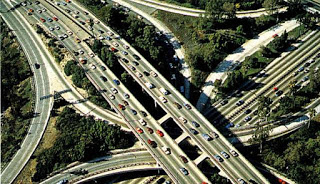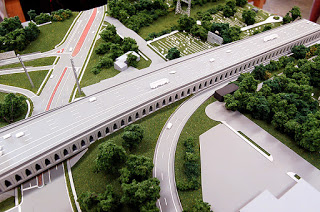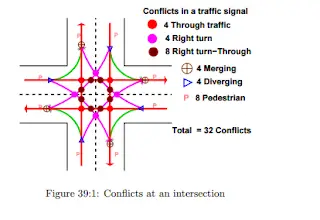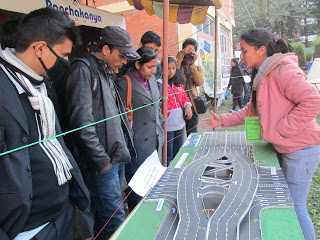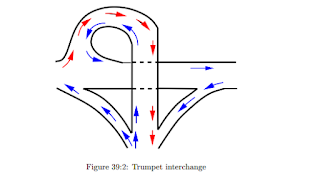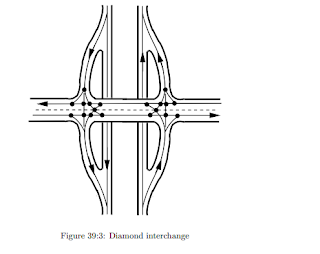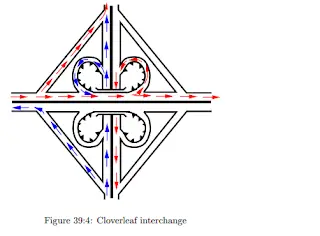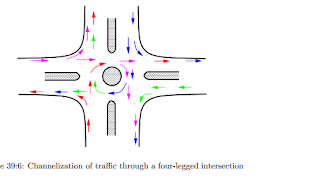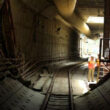Intersection is an area shared by two or more roads. This area is designated for the vehicles to turn to different directions to reach their desired destinations. Its main function is to guide vehicles to their respective directions. Traffic intersections are complex locations on any highway. This is because vehicles moving in different direction wan to occupy same space at the same time.
In addition, the pedestrians also seek same space for crossing. Drivers have to make split second decision at an intersection by considering his route, intersection geometry, speed and direction of other vehicles etc. A small error in judgment can cause severe accidents. It also causes delay and it depends on type, geometry, and type of control.
Overall traffic flow depends on the performance of the intersections. It also affects the capacity of the road. Therefore, both from the accident perspective and the capacity perspective, the study of intersections very important for the traffic engineers especially in the case of
Conflicts at an intersection are different for different types of intersection. Consider a typical four-legged intersection as shown in figure. The number of conflicts for competing through movements are 4, while competing right turn and through movements are 8. The conflicts between right turn traffics are 4, and between left turn and merging traffic is 4. The conflicts created by pedestrians will be 8 taking into account all the four approaches. Diverging traffic also produces about 4 conflicts. Therefore, a typical four legged intersection has about 32 different types of conflicts.
The essence of the intersection control is to resolve these conflicts at the intersection for the safe and efficient movement of both vehicular traffic and pedestrians. Two methods of intersection controls are there: time sharing and space sharing. The type of intersection control that has to be adopted depends on the traffic volume, road geometry, cost involved, importance of the road etc.
Levels of intersection control
The control of an intersection can be exercised at different levels. They can be either passive control, semi control, or active control. In passive control, there is no explicit control on the driver . In semi control, some amount of control on the driver is there from the traffic agency. Active control means the movement of the traffic is fully controlled by the traffic agency and the drivers cannot simply maneuver the intersection according to his choice.
Passive control
When the volume of traffic is less, no explicit control is required. Here the road users are required to obey the basic rules of the road. Passive control like traffic signs, road markings etc. are used to complement the intersection control. Some of the intersection control that are classified under passive control are as follows:
1. No control If the traffic coming to an intersection is low, then by applying the basic rules of the road like driver on the left side of the road must yield and that through movements will have priority than turning movements. The driver is expected to obey these basic rules of the road.
Traffic signs: With the help of warning signs, guide signs etc. it is able to provide some level of control at an intersection. Give way control, two-way stop control, and all-way stop control are some examples. The GIVE WAY control requires the driver in the minor road to slow down to a minimum speed and allow the vehicle on the major road to proceed. Two way stop control requires the vehicle drivers on the minor streets should see that the conflicts are avoided.
Finally an all-way stop control is usually used when it is difficult to differentiate between the major and minor roads in an intersection. In such a case, STOP sign is placed on all the approaches to the intersection and the driver on all the approaches are required to stop the vehicle. The vehicle at the right side will get priority over the left approach. Thetraffic control at ’at-grade’ intersection may be uncontrolled in cases of low traffic. Here the road users are required to obey the basic rules of the road. Passive control like traffic signs, road markings etc. are used to complement the intersection control.
Traffic signs plus marking: In addition to the traffic signs, road markings also complement the traffic control at intersections. Some of the examples include stop line marking, yield lines, arrow marking etc.
Semi control
In semi control or partial control, the drivers are gently guided to avoid conflicts. Channelization and traffic rotaries are two examples of this.
Channelization:
The traffic is separated to flow through definite paths by raising a portion of the road in the middle usually called as islands distinguished by road markings. The conflicts in traffic movements are reduced to a great extent in such a case. In channelized intersections, as the name suggests, the traffic is directed to flow through different channels and this physical separation is made possible with the help of some barriers in the road like traffic islands, road markings etc.
Traffic rotaries:
It is a form of intersection control in which the traffic is made to flow along one direction around a traffic island. The essential principle of this control is to convert all the severe conflicts like through and right turn conflicts into milder conflicts like merging, weaving and diverging. It is a form of ‘at-grade’ intersection laid out for the movement of traffic such that no through conflicts are there. Free-left turn is permitted where as through traffic and right-turn traffic is forced to move around the central island in a clock-wise direction in an orderly manner. Merging, weaving and diverging operations reduces the conflicting movements at the rotary.
Active control
Active control implies that the road user will be forced to follow the path suggested by the traffic control agencies. He cannot maneuver according to his wish. Traffic signals and grade separated intersections come under this classification
Traffic signals: Control using traffic signal is based on time sharing approach. At a given time, with the help of appropriate signals, certain traffic movements are restricted where as certain other movements are permitted to pass through the intersection. Two or more phases may be provided depending upon the traffic conditions of the intersection. When the vehicles traversing the intersection is very large, then the control is done with the help of signals. The phases provided for the signal may be two or more. If more than two phases are provided, then it is called multiphase signal.
The signals can operate in several modes. Most common are fixed time signals and vehicle actuated signals. In fixed time signals, the cycle time, phases and interval of each signal is fixed. Each cycle of the signal will be exactly like another. But they cannot cater to the needs of the fluctuating traffic. On the other hand, vehicle actuated signals can respond to dynamic traffic situations. Vehicle detectors will be placed on the streets approaching the intersection and the detector will sense the presence of the vehicleand pass the information to a controller. The controller then sets the cycle time and adjusts the phase lengths according to the prevailing traffic conditions.
Grade separated intersections:
The intersections are of two types. They are at-grade intersections and grade-separated intersections. In at-grade intersections, all roadways join or cross at the same vertical level. Grade separated intersections allows the traffic to cross at different vertical levels. Sometimes the topography itself may be helpful in constructing such intersections. Otherwise, the initial construction cost required will be very high. Therefore, they are usually constructed on high speed facilities like expressways, freeways etc. These type of intersection increases the road capacity because vehicles can flow with high speed and accident potential is also reduced due to vertical separation of traffic.
Grade separated intersections
As we discussed earlier, grade-separated intersections are provided to separate the traffic in the vertical grade. But the traffic need not be those pertaining to road only. When a railway line crosses a road, then also grade separators are used. Different types of grade-separators are flyovers and interchange. Flyovers itself are subdivided into overpass and underpass. When two roads cross at a point, if the road having major traffic is elevated to a higher grade for further movement of traffic, then such structures are called overpass. Otherwise, if the major road is depressed to a lower level to cross another by means of an under bridge or tunnel, it is called under-pass.
Interchange is a system where traffic between two or more roadways flows at different levels in the grade separated junctions. Common types of interchange include trumpet interchange, diamond interchange , and cloverleaf interchange.
1. Trumpet interchange:
Trumpet interchange is a popular form of three leg interchange. If one of the legs of the interchange meets a highway at some angle but does not cross it, then the interchange is called trumpet interchange.
2. Diamond interchange:
Diamond interchange is a popular form of four-leg interchange found in the urban locations where major and minor roads crosses. The important feature of this interchange is that it can be designed even if the major road is relatively narrow.
3. Clover leaf interchange:
It is also a four leg interchange and is used when two highways of high volume and speed intersect each other with considerable turning movements. The main advantage of cloverleaf intersection is that it provides complete separation of traffic. In addition, high speed at intersections can be achieved. However, the disadvantage is that large area of land is required. Therefore, cloverleaf interchanges are provided mainly in rural areas.
Channelized intersection
Vehicles approaching an intersection are directed to definite paths by islands, marking etc. and this method of control is called channelization. Channelized intersection provides more safety and efficiency. It reduces the number of possible conflicts by reducing the area of conflicts available in the carriageway. If no channelizing is provided the driver will have less tendency to reduce the speed while entering the intersection from the carriageway. The presence of traffic islands, markings etc. forces the driver to reduce the speed and becomesmore cautious while maneuvering the intersection. A channelizing island also serves as a refuge for pedestrians and makes pedestrian crossing safer.

